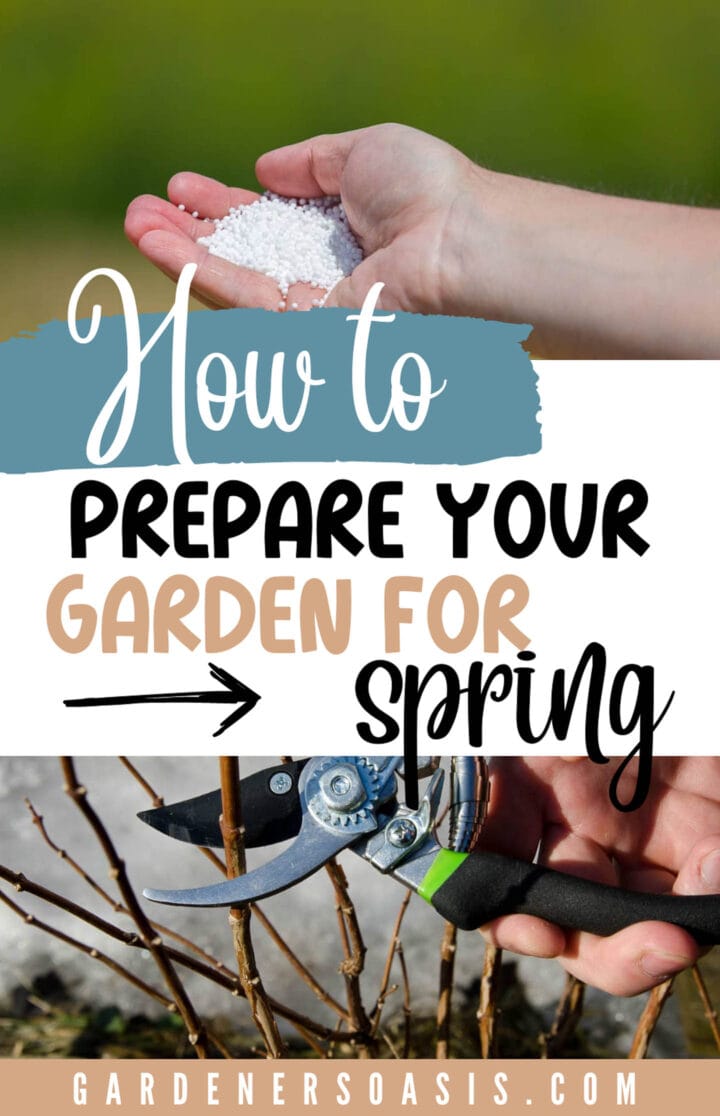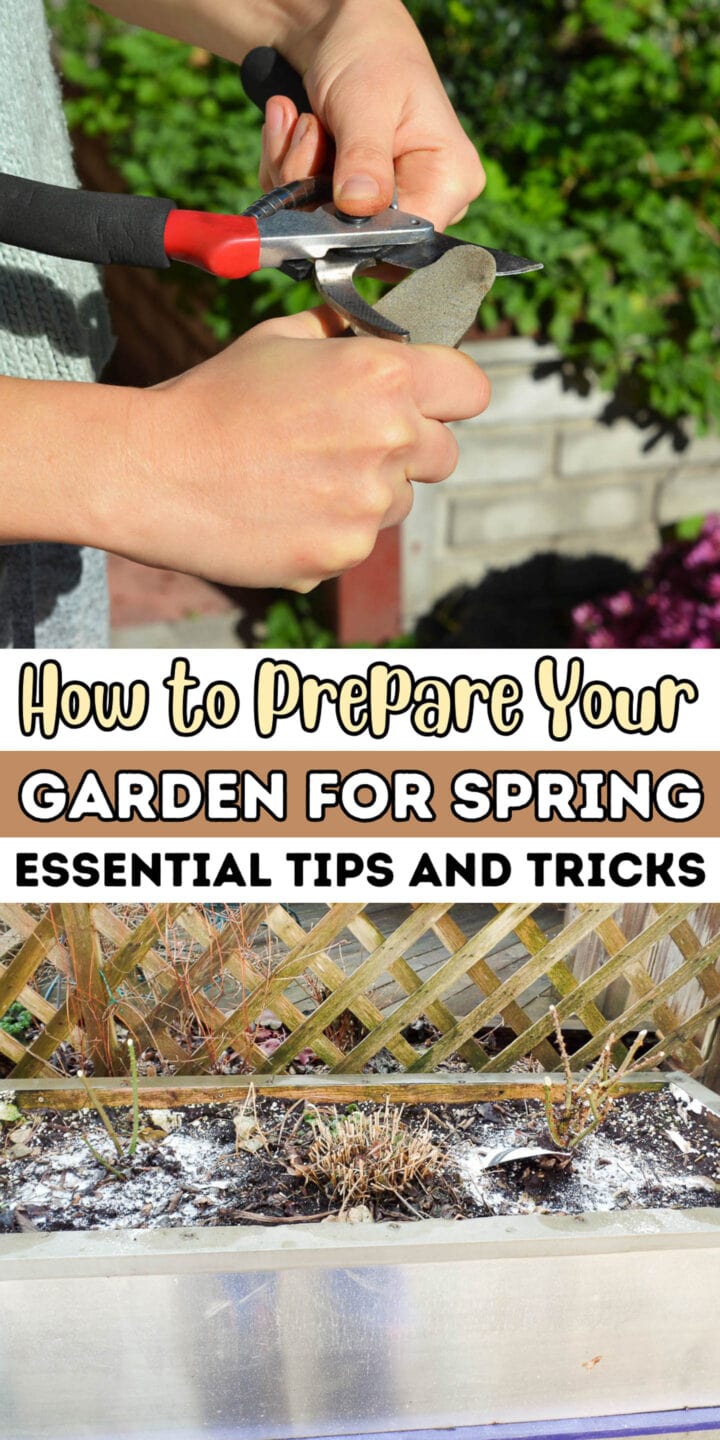How To Prepare Your Garden For Spring
As winter slowly loosens its grip and the days grow warmer, thoughts naturally turn to the garden. For many of us, that means eagerly anticipating the first signs of life poking up through the soil. But before we can fully enjoy all that our garden has to offer, there's some work to be done. Here are a few tips on how to prepare your garden for spring.

The snow is finally melting and the ground is starting to thaw.
That can only mean one thing: SPRING IS COMING!
If you're like most gardeners, you've been impatiently waiting all winter long to get started on your gardening plans.
And now you're itching to get outside, but it's too early to actually start planting.
Fortunately, there's still a lot of jobs that can be done to prepare your garden for spring.
So here's our tips of what needs to be on your spring garden cleanup list to help you get started.
1 | Pick Up The Garbage

This isn't a very glamorous task, but you will be surprised how much garbage has accumulated in your garden over the winter months!
Walk around with a plastic bag and retrieve all the bits of paper and trash that have blown onto your property since the fall.
If you live in a neighborhood like mine, you will also likely need a small spade to pick up after those dog walkers who have neglected to be courteous.
2 | Rake up debris

Another necessary job for your spring garden maintenance is cleaning up plant debris such as leaves, twigs, dirt and mulch that has escaped its flower bed.
Leaving the extra layers on your garden bed and lawn can stunt the spring growth of perennials, bulbs and grass.
So early spring is the perfect time to rake up and compost all of that extra organic material.
Use a fan rake for this because you do not want to risk pulling up any grass or perennial roots.
3 | Sharpen your pruning shears

Next, I like to take the pruning shears and other garden tools to the hardware store for sharpening so that they are in good shape for the rest of the year.
You can also sharpen pruners yourself with a sharpening stone or the tool sharpening Dremel attachment.
4 | Trim back perennials

I leave most of my perennials and grasses untrimmed in the fall so that they provide winter food and shelter for the birds. Which means they look very ratty and unkempt this time of the year.
So I go around with my newly-sharpened pruning shears and trim them to an inch or two from the ground.
Try to avoid any root damage by cutting off the old stems rather than yanking at them.
I clean up the perennials, grasses, and the peonies (except the tree peonies).
As well as removing any other dead plant material.
Cut back the clematis climbers depending on when they bloom. The spring bloomers get trimmed back to the top sprouting buds, the summer bloomers get trimmed to 2-3 feet from the ground. The fall blooming Clematis can be kept in check by cutting the stems to 1 foot from the ground.
5 | Prune trees and shrubs

Now is also the time to remove old wood from bushes and trees.
Avoid severe pruning of the spring blooming plants, such as the lilacs, azaleas, rhododendrons, and Japanese Pieris since you will likely cut off the blooms.
For other plants (including fruit trees and shrubs) cut off any broken or crossing branches.
Roses can be pruned back now, although I usually only tidy the climbers and re-tie them to their supports.
Resist touching the hydrangeas that bloom on old wood. It is too early to remove the old blossoms. This can be done only after all danger of frost is past. You can find more information on when and how to prune Hydrangeas HERE.
6 | Fertilize

Early spring is a great time to give your garden a head start with the nutrients it needs by putting down fertilizer.
Throw a handful of azalea/rhododendron fertilizer, soil acidifier around the azaleas, rhododendrons, pieris, blueberries, and blooming dogwoods. This is only necessary if your soil is not naturally acidic. (If you're not sure what your soil pH is, doing a soil test is a good way to find out).
Toss a handful of Epsom salts under every rose bush. This is an organic fertilizer that replenishes the magnesium in the soil and enhances growth and vigor. I think it helps combat black spot and mildew and is much less expensive than chemical rose fertilizer. It can be purchased in the drug store.
Add triple-mix or manure on top of the soil around all bushes. Keep it an inch or 2 away from the stems to prevent burning the bark. I don't ever get around to doing the entire garden so I choose an area that did not get any organic matter added last year.
If you have a compost bin, empty its contents onto the rhubarb patch and the raspberry patch, or any other perennial fruit and vegetables. If I do not have enough, I apply purchased sheep or cattle manure to the raspberries, strawberries and blueberries annually. There is no digging involved with this process. I let the worms and rain draw the new organic matter into the soil.
7 | Clean the deck and outdoor furniture

Hose the pathways with water, and scrub and rinse the deck.
This DIY deck cleaning solution works really well and won't harm your plants.

Wet the deck first, scrub with a long handled deck brush and rinse very well with the hose.
Note: Do not clean your wooden deck with a power washer because the powerful spray may soften the wood and cause more rapid deterioration.
While the deck is drying, bring the deck furniture out and clean it with soap and water. Also make note of any repairs.
8 | Make a repair list

Speaking of repairs, there may be other things in your garden that require fixing now that winter is over.
Make a note of those hard structures (like gates, fences and trellises) that need to be repaired, painted, or replaced.
Picket fences (like the one I have in the front yard) can be salvaged with a few new boards.
Also check your outdoor lights to see if any are broken or need new bulbs.
9 | Clean up garden art, bird baths and fountains

The next of our spring gardening tips is to clean up any garden art (such as statues), bird baths and fountains you may have in your garden.
Since soil often shifts over the winter, they may need to be straightened, adjusted or moved to a more stable location.
Then clean them thoroughly with soap and water.
I don't usually fill the fountains with water yet (or put out the pumps), unless I am sure there won't be getting any more freezing weather.
10 | Pull early spring weeds

If you live in an area where the weeds start to grow early, pull them out of the garden and raised beds now so they don't have time to go to seed.
This will help to keep them from spreading.
11 | Clean shovels and other garden tools
If you didn't get around to cleaning your garden tools in the fall, early spring is the perfect time to get them ready for the new season.
Wash off any dirt and scrape off rust to keep them looking and functioning their best.
When to start the spring garden cleanup?
I like to start this spring garden prep work when the weather starts to get warmer (above 50 degrees F) but before the growing season for bulbs and perennials has begun so that I do not trample the new growth.
My aim is to have all of this spring cleanup completed before the last frost date. (If you're not sure when that is for your area, you can look it up HERE).
That way the garden will be in order when the weather is warm enough to start planting.
Other spring gardening ideas you might like
- 10 tips for creating a low maintenance garden
- Early spring white flowering trees
- Blue flowering bulbs and perennials for early spring
- Early spring purple flowers
Have comments or questions on how to get your garden ready for spring? Tell us in the section below.
This post was originally published on March 23, 2016 but was updated with new content on November 23, 2024.










Dear Wanda, as always it nice to hear from you, yes spring is here, and so comes gardening. We here in Ireland are having some lovely spring weather, so today was my first day to get started, and my don’t the weeds grow fast.
I have a great problem with moss ( no doubt due to our wet climate) even the flower beds are covered in moss, have you any suggestions on how to get rid of it? I know digging it out may help, but wonder is there an easier option, as I am getting a lot of trouble with my back ( probably an age thing ) so any suggestions would be great.
Many thanks. Breeda
Hi Breeda…I haven’t tried it, but I have heard that spraying moss with dish soap mixed with luke-warm water will kill it without harming the plants. Mix 1/4 cup of soap with 1 gallon (or about 4 liters) of water. Spray it on and let it sit for 24 hours. The moss should turn brown and shrivel up. I hope that helps!